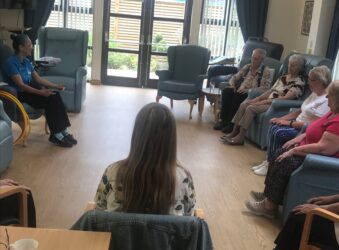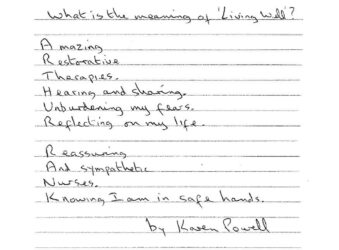Complementary Therapist shares Reflexology tips with Hospice patients
Share this story
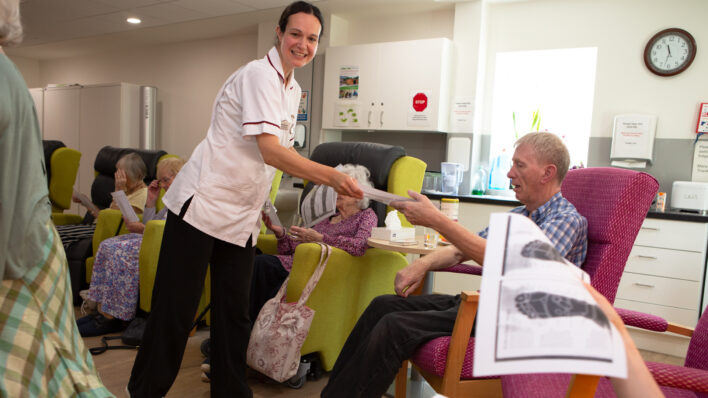
Reflexology (a gentle pressure technique using the thumbs and fingers on specific reflex points found in the feet and also the hands, face or ears) is just one of a range of services provided by the Charity, to people in Cambridgeshire living with an advanced serious illness or other life-limiting condition and those who need end of life care.
This usually takes place at the Hospice in one of the treatment rooms at the Bradbury Wellness Centre or on the Inpatient Unit and also in patients own homes in the community.
Complementary Therapist, Marianna Armstrong, recently spent a morning with the Living Well patients sharing more about Reflexology. She started by explaining it is a practice which is designed to work alongside mainstream medicine – and not as a replacement. It may help with alleviating symptoms and it may support a person holistically, meaning it can help on a physical, emotional and spiritual level.
Reflexology is not a new therapy, which some may have thought, as it has been around for over 5,000 years, with evidence of it being used in The America’s and Ancient Egypt.
Zone Therapy
Dr William Fitzgerald was the pioneer of ‘zone therapy’, from which Modern Reflexology developed. His zone therapy involved splitting the body into ten longitudinal zones, five on the left and five on the right and he emphasised the connection between reflex points on the hands and feet and various internal organs within the same zone.
For example, he demonstrated how exerting pressure on parts of the hands and feet may produce relief from pain elsewhere in the body.
His work was further developed by a physiotherapist named Eunice Ingham, affectionately known as the ‘Mother of Reflexology’ and her methods are still used today.
Reflexology on the feet
It is most common for Reflexology to be carried out on the feet as these are more sensitive and therefore more responsive to treatments. There are over 7,000 nerves in the feet!
Different parts of the feet relate to different organs and structures of the body. By stimulating the reflex points, tension and blockages in the meridians (energy channels or zones) are released and vital energy (QI (Chi), Ki or Prana) can flow more freely and the body may achieve balance – homeostasis.
How it works?
There are many theories as to how Reflexology works – such as through nerve impulse stimulation, circulation theory, stimulation of ‘feel good’ endorphins, fascia involvement or simply the power of touch. The exact way it works has not been agreed.
Benefits of Reflexology
Marianna added that sometimes people feel emotional at the end of a session and some people become tearful and feel a release and as if they have ‘let something go’. Often people feel better after this release, using words such as ‘lighter’ and ‘more positive’.
One of the patients curiously asked, “What if you are ticklish?” and Marianna explained the practice is a firm but gentle pressure, which tends not to be ticklish.
Marianna continued:
“One element of Chinese philosophy states that the bodily organs are related to emotions. So, by stimulating the organs’ reflex points in the feet, emotions can be released and a healing takes place.
I have seen Reflexology help with digestion, muscular aches, sleep, fertility, psychological symptoms – such as anxiety, fatigue and low mood. Studies have also shown that CIPN (Chemo Induced Peripheral Neuropathy – a numbness which may be brought on by Chemotherapy) can be helped by Reflexology.”
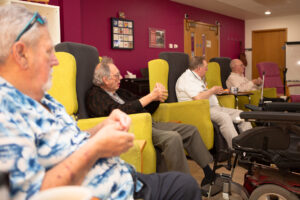
“One patient came to me with a pain in their right shoulder which was, initially, too painful to massage. Over the period of three weeks, the pain was improved by working on the relative right shoulder area.
Another patient had severe shortness of breath and relied on extra Oxygen to support them. During the Reflexology session they felt so relaxed.
One other patient was struggling to sleep. Initially, after the Reflexology session they said they didn’t feel any different but when they returned, they told me that they had started to get to sleep at 9:00pm instead of midnight.”
Reflexology in practice
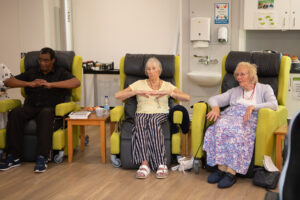
Marianna concluded the session with some simple Reflexology movements that the patients could carry out on their own hands. She advised that if they had a cut, bruise, rash, infection, swollen areas or unexplained pain then to avoid that area.
“I continue to be amazed at the responses people have to Reflexology sessions, and they are often amazed too!”
Patients at Arthur Rank Hospice Charity are offered four sessions of Complementary Therapy. The Cambridge Cancer Help Centre in Great Shelford (near Scotsdales) also offers Complementary therapy sessions, including Reflexology.
View other stories
-

Russell shares his Living Well experience
"There’s a very, very good and tight family atmosphere here"
-

Susan shares her Living Well Experience
"I wanted to come somewhere just to think about having hope, when living with a condition like this"
-

Patients ‘Love to Move’ at the Alan Hudson Centre
Patients at the Alan Hudson Centre in Wisbech get moving
-

Living Well poems
Some wonderful poems penned by a patients and relatives of the Living Well Service



